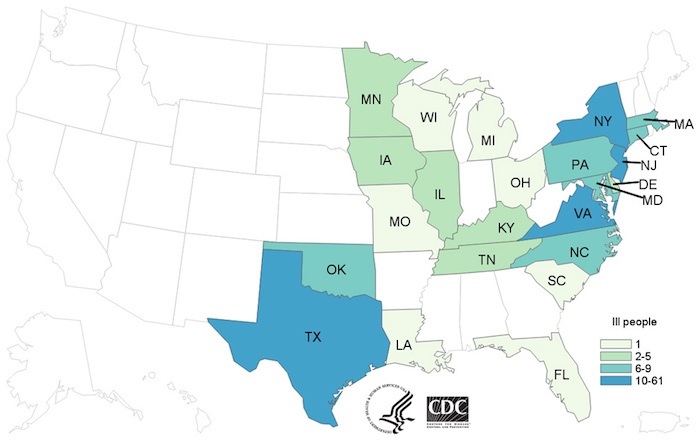The multistate Salmonella outbreak linked to imported Maradol papayas has now sickened at least 201 people in 23 states. One person in New York City has died. Since the last update on August 18, 2017, 28 more people have been sickened and two more states have reported ill persons: Florida and South Carolina.
And the CDC says there are two more Salmonella outbreaks linked to papayas that were imported from two other farms in Mexico. A total of nine people are sickened in those two outbreaks, for a total of 210.

The case count by state in the main outbreak is: Connecticut (7), Delaware (4), Florida (1), Iowa (2), Illinois (5), Kentucky (4), Louisiana (1), Maryland (9), Massachusetts (8), Michigan (1), Minnesota (4), Missouri (1), North Carolina (6), New Jersey (39), New York (61), Ohio (1), Oklahoma (8), Pennsylvania (8), South Carolina (1), Tennessee (2), Texas (10), Virginia (17), and Wisconsin (1). Illnesses started on dates ranging from May 17, 2017 to August 20, 2017. The patient age range is less than 1 year to 95, with a median age of 37.
Among 196 ill persons interviewed in the main outbreak, 118 are female. Among 158 people interviewed, 65, or 41%, have been hospitalized. This is a very high hospitalization rate, almost twice the typical rate in Salmonella outbreaks, which is 22%.
Two additional outbreaks of Salmonella infections linked to imported papayas from two other farms in Mexico have been identified. Those farms are Caraveo Produce and El Zapotanito. Public health officials are investigating, to determine if more consumer warnings are needed beyond the advice to avoid papayas from specific farms.
The CDC now recommends that consumers not eat, restaurants not serve, and retailers not sell, Maradol papayas from the Carica de Campeche, Caraveo Produce, or El Zapotanito farms in Mexico. But because three separate outbreaks have been identified, the CDC thinks that several other farms in Mexico may be contaminated with Salmonella bacteria and have made others sick.
The FDA is increasing testing of papayas from Mexico as they come into the country. Shipments of papayas that were contaminated were destroyed and not distributed for sale in the U.S. Any past shipments of papayas from the newly identified farms are no longer on the market because they are past their shelf life.
There are four different types of Salmonella bacteria in the main outbreak. They are Salmonella Thompson, Kiambu, Agona, and Gaminara. The case count by strain is Salmonella Thompson (131), Salmonella Kiambu (57), Salmonella Agona (8), and Salmonella Gaminara (5). The same strain of these types of Salmonella were found in samples collected form papayas and from isolates taken from patients.
The two other outbreaks have been caused by Salmonella Newport, Salmonella Infantis, and Salmonella Urbana. Salmonella Newport and Infantis were found in an imported papaya sample collected from Caraveo Produce in Tecomán, Mexico. CDC identified three people in the PulseNet database who were infected with the same DNA fingerprint of Salmonella Newport (2) or Salmonella Infantis (1). The ill people were reported from three states: Illinois, Massachusetts, and Michigan.
The third outbreak, caused by Salmonella Urbana bacteria, was caused by papayas from El Zapotanio in La Huerta, Mexico. CDC identified six people in the PulseNet database who were infected with the same DNA fingerprint of Salmonella Urbana. The ill people were reported from three states: New Jersey (4), New York (1), and Pennsylvania (1).
If you purchased Maradol papayas imported from these farms in Mexico, do not eat them. Throw them away in a sealed container or take them back to the store where you bought them for a full refund. If you aren’t sure whether or not you have purchased these fruits, ask your retailer.
After you have disposed of the papayas, clean out your refrigerator and wherever the fruit was stored with a mild bleach solution to kill any remaining bacteria.
The symptoms of a Salmonella infection include nausea, vomiting, diarrhea, muscle aches, and fever. Most people get sick within 12 to 72 hours after exposure to the bacteria. And most people don’t go to a doctor, so these numbers are very underreported. The multiplier for Salmonella infections is 38, so there could be almost 8,000 people sickened in these three outbreaks. If you do feel sick after you have eaten imported Maradol papayas, see your doctor.
The law firm of Pritzker Hageman helps people sickened by contaminated food such as the recalled Maradol papayas protect their legal rights, and get compensation and justice. Our lawyers represent patients and the families of children sickened with bacterial infections in personal injury and wrongful death lawsuits against growers, retailers, food producers, food processors, restaurants, schools, and others. Attorney Fred Pritzker recently won $7.5 million for young client whose kidneys failed because of hemolytic uremic syndrome after an E. coli infection. Class action lawsuits may not be appropriate for outbreak victims because the cases are very unique.




